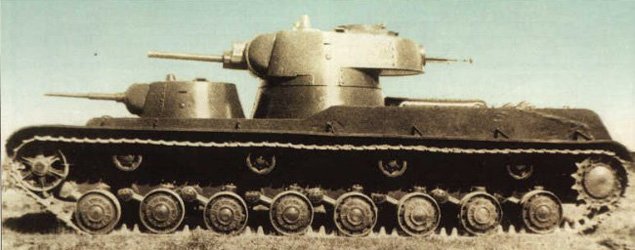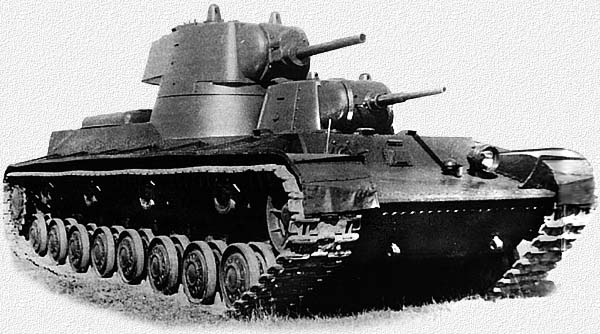Fire in the Steppe:
The T-35 Land Battleship, Part 3
by Mike Bennighof, Ph.D.
February 2024
 With the T-35 deemed unable to continue in its intended role as a heavy breakthrough tank, multiple Soviet design bureaus went to work drafting potential replacements. The new tank would have to fulfill the land battleship’s role of smashing through fortifications and engaging soft targets, while also defending itself from enemy tanks. With the T-35 deemed unable to continue in its intended role as a heavy breakthrough tank, multiple Soviet design bureaus went to work drafting potential replacements. The new tank would have to fulfill the land battleship’s role of smashing through fortifications and engaging soft targets, while also defending itself from enemy tanks.
While no Soviet heavy tanks went to Spain for the Civil War, experience gleaned there showed that the light T-26 tanks deployed in support of the Republican forces were vulnerable to the 37mm anti-tank guns of the Nationalists and to field guns deployed in an anti-tank role. The new tank would have to be proof against light anti-tank guns at close range and field guns (75mm or 76.2mm) at longer ranges. It should have a diesel engine, to reduce the threat of fires and fuel explosions, and wider tracks than the T-35 to better distribute the great weight of the vehicle.
 Initial design requirements called for five turrets, just like the T-35, later reduced to three: one with a 76.2mm gun and two others each bearing a 45mm anti-tank gun. While the design bureau at Kharkov Locomotive Works continued to hopefully draft a modified T-35 to meet the new role, a pair of Leningrad design teams worked up new tank proposals, the Kirovski (formerly Putilov) Works and the Bolshevik Plant. Both teams presented their drafts and simple wooden mock-ups in October 1938; each had deviated from the original requirements by abandoning the suspension and drive train of the T-35 but the Automotive and Tank Directorate accepted the designers’ arguments that these had already been inadequate for the older tank and would not serve for an even heavier machine. Initial design requirements called for five turrets, just like the T-35, later reduced to three: one with a 76.2mm gun and two others each bearing a 45mm anti-tank gun. While the design bureau at Kharkov Locomotive Works continued to hopefully draft a modified T-35 to meet the new role, a pair of Leningrad design teams worked up new tank proposals, the Kirovski (formerly Putilov) Works and the Bolshevik Plant. Both teams presented their drafts and simple wooden mock-ups in October 1938; each had deviated from the original requirements by abandoning the suspension and drive train of the T-35 but the Automotive and Tank Directorate accepted the designers’ arguments that these had already been inadequate for the older tank and would not serve for an even heavier machine.
The two designs looked very similar, with the 76.2mm gun’s turret mounted on a raised barbette that fired over the 45mm turrets. One of these smaller fixtures was placed in front of the barbette and the other behind it, to give full coverage around the tank.
The Central Committee reviewed the tank designs in December 1938 – this being an issue of such importance that it required oversight from the very top of Soviet authority. Josef Stalin approved the designers’ request to help lighten the vehicle by deleting one of the seven-ton 45mm turrets. “There’s no need to turn this tank into a land battleship,” the “Brilliant Genius of Humanity” supposedly said. “Take these seven tons away and strengthen the armor.”

The SMK prototype.
Approval to build actual prototypes soon followed, and construction began in January 1939. The Kirov tank, known as the SMK (Sergei Mironovich Kirov) after the plant’s namesake, a Stalin associate assassinated in 1934, had its first test drive at the end of April. Following more work at the plant, field testing began in the summer. The Bolshevik Plant’s tank, known as the T-100, experienced delays in its construction and only had its first test drive on the last day of July.
No diesel engine could provide the needed power, and both prototypes carried a modified version of the gasoline-powered 12-cylinder AM-34 aircraft engine that also drove the Tupolev TB-3 heavy bomber, most Soviet motor torpedo boats and the Type 1124 and Type 1125 river monitors.
The Kirov design team also drafted and built a smaller version of the SMK with only one turret. This tank, known as the KV for Defense Minister Klimenti Voroshilov, had only the larger turret, mounted flush with the hull which greatly reduced the machine’s weight. That allowed thicker armor, but also reduced the strain on the engine enough to allow fitting of a diesel power plant.
The designers argued to Stalin that the newly-developed L11 model of the 76.2mm gun gave superior anti-tank performance to the 45mm Model 38 tank cannon of the smaller turret on the SMK and T-100 (and also on the T-35). Therefore, one cannon could perform both missions, suppressing soft targets and fortifications with high-explosive rounds and battling enemy tanks with armor-piercing ammunition. The “Gardener of Human Happiness” approved construction of a prototype over the objections of his crony Grigory Kulik, the Director of Artillery, who urged that the designers be shot for their impertinence. The KV was classed as an experimental vehicle, and apparently not expected to be chosen over either of its larger rivals.
The Red Army invaded Finland in late November 1939, providing an opportunity for additional testing under actual combat conditions. All three prototypes were bundled off to the Karelian Front and assigned to the 20th Heavy Tank Brigade for use in the assault on the Finnish Mannerheim Line fortifications. The T-100, SMK and KV went into action with mixed crews of experienced tankists and factory technicians given a crash course in military tactics before their deployment in battle.

Another view of the SMK prototype.
The experimental platoon went into action on 17 December in the Summa sector, and remained in combat until the 20th, when the SMK tried to run over a stack of wooden crats that turned out to be camouflage for an improvised explosive device. The blast left the tank immobile but did not harm the crew, who tried to repair the damaged engine for several hours while the Finns blazed away at the tank with 37mm guns and the T-100 stood by its stricken comrade to offer covering fire, shrugging off at least seven direct hits while a Finnish shell sheared off the KV’s gun barrel.
Finally the crew gave up the effort and slid out the escape hatch in the bottom of the tank and crawled through the similar entry into the T-100. Efforts to tow the damaged tank away failed, and 20th Tank Brigade lost 47 men in attempts to bring the damaged vehicle away. The SMK was not recovered until February. By that point, the Automotive and Tank Directorate had made its recommendations: all three tanks met the stated requirements, but the KV would be much easier to manufacture and offered superior protection against enemy fire. The production order went out on 19 December; whether the Directorate considered the results of the small battle at Summa in the decision is unclear.
The one weakness noted, shared by all three tanks, was the inability of the 76.2mm L11 to knock out the Finnish steel-reinforced concrete bunkers. A secret crash program began to prepare a version of the KV fitted with a 152mm howitzer. The Kirov plant began serial production of the KV, now designated KV-1 to distinguish it from the 152mm-armed version, in February 1940 alongside the hastily-designed KV-2.
The SMK’s hulk would eventually be sent to the Kubinka test facility near Moscow, where it rusted away until scrapped in the 1950’s. The T-100 remained in combat in Karelia until February 1940, afterwards also heading to Kubinka where it would also be melted down at some disputed date.
Even as the new tanks took shape on the drawing board, their age had ended, prompting the Kirov team to draw up a single-turreted tank to perform the same mission. The KV was superior in every respect to its bigger sisters, and would help win the Great Patriotic War when it erupted less than 18 months after it began production.
You can order Fire in the Steppe right here.
You can order Journal No. 25: Land Battleships right here.
Steppe Experience
Fire in the Steppe
Kursk: Burning Tigers
Eastern Front Artillery
Retail Price: $214.97
Package Price: $170
Gold Club Price: $134
You can order the Steppe Experience right here.
Sign up for our newsletter right here. Your info will never be sold or transferred; we'll just use it to update you on new games and new offers.
Mike Bennighof is president of Avalanche Press and holds a doctorate in history from Emory University. A Fulbright Scholar and NASA Journalist in Space finalist, he has published a great many books, games and articles on historical subjects; people are saying that some of them are actually good.
He lives in Birmingham, Alabama with his wife and three children. He misses his lizard-hunting Iron Dog, Leopold. Leopold once befriended a squirrel.
Want to keep Daily Content free of third-party ads? You can send us some love (and cash) through this link right here.
|
